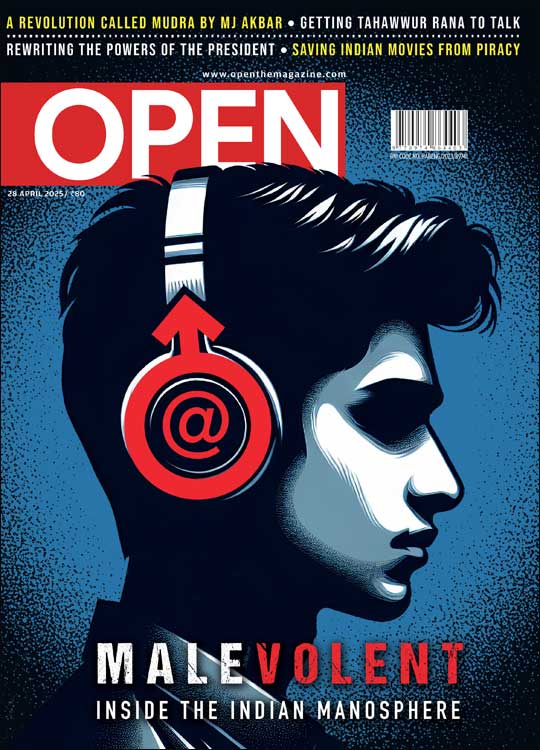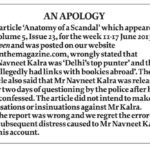Rigour Mortis
The pursuit of justice in Mumbai’s terror cases demands an investigative thoroughness. Which, for all practical purposes, seems dead
 Sreenivasan Jain
Sreenivasan Jain
 Sreenivasan Jain
|
28 Jul, 2011
Sreenivasan Jain
|
28 Jul, 2011
/wp-content/uploads/2015/11/ineptitude2.jpg)
The pursuit of justice in Mumbai’s terror cases demands an investigative thoroughness. Which, for all practical purposes, seems dead
I spent the morning on a long conversation with Saqib Nachan, described by the Mumbai Police as a ‘terrorist mastermind’, someone who allegedly trained and armed Muslim youth to execute a series of terror attacks that struck Mumbai in late 2002 and through 2003, killing and wounding dozens. The reason I was able to talk to him this week is not because I was given special access to his prison cell, but because he is out on bail. Nachan was speaking to me from his native Padgha, a semi-rural hamlet two hours north of Mumbai, where he says he has returned to his family business of ‘land development’. This transformation—from life as an alleged dreaded militant boss accused of multiple attacks to a regular work routine—is not an isolated instance. Soon after, I spoke to another ‘ringleader’ of another Mumbai blast, Dr Abdul Mateen, who has been fully acquitted, now at home in Aurangabad practising medicine.
Those who read this, with the horror of 13 July still fresh in memory, may feel angry. Anger is important, but misdirected anger is counterproductive. It is true that men charged in the past with serious acts of terror are now out of prison, leading free lives. Does this mean there is no justice? These men would argue that this is justice—they are free or out on bail not by accident, but by legal decree. They would even argue that injustice has been done unto them—one of them has spent about eight years in prison, roughly twice the minimum penalty under Pota, the anti-terror law under which they were charged. But the victims of the blasts with which these men were charged also feel robbed of justice—who is it, then, that killed their fathers, sons, daughters, wives?
Mostly, these questions are co-opted by the usual media flotilla of politicians, city notables and prime-time pundits who convert them into expressions of glib outrage and demands for ‘justice’, which are usually forgotten by the end of the news cycle. Any genuine attempt to seek answers would require a dogged engagement with the slow, grinding progress—or, as we shall see, paralysis—of Mumbai’s previous blast cases.
It means staying with the story long after the candlelit vigils have ended, suspects been arrested, terror masterminds named and chargesheets filed. At the very least, this may help locate these calls for ‘justice’ in a less vacuous and more informed commentary. At the very best, sustained and informed public attention might spur India’s law enforcement machinery to be more rigorous in making claims to the public and in courts of law. It might even hasten the Judiciary’s delivery of justice in cases of terror, both long-pending and new ones.
As it stands, this is the depressing algebra of Mumbai’s bombing cases: seven blasts (or blast cases) in a span of four years from late 2002 to 2006, counting Ghatkopar, Bombay Central, Vile Parle, Mulund, a second Ghatkopar blast, the twin Gateway and Zaveri Bazaar blasts, and the serial train blasts of 2006. That’s 280 people killed, and perhaps thrice that number wounded. Of the seven cases, one has collapsed outright, three others are on the verge of collapse, with most of the accused out on bail (and trials not even begun), and a trial has only just started in the fifth case, three years after the incident; there have been only two convictions.
Let’s first tackle the wave of bombings that hit the city in the aftermath of the Gujarat riots of March 2002. From December 2002 to August 2003, Mumbai suffered six blasts in nine months, all linked by the ‘Gujarat revenge’ theory and by the police’s forceful contention that they were the handiwork of Lashkar-e-Toiba (LeT) modules that had become active in western India in tandem with the Students Islamic Movement of India (Simi).
Apart from the timing, the revenge theory was given weight by the targets selected: mostly residential Gujarati areas like Ghatkopar, Mulund and Vile Parle, or Gujarati-frequented commercial hubs like Zaveri Bazaar. While making their second claim, of LeT-Simi links, the police brought in some of Mumbai’s ‘encounter specialists’. This was their high noon. By the late 1990s, they had cleaned up the underworld and needed a new target. Many of them were assigned to the blast cases, and they deployed some of the methods they had used in their fight against gangsters in the fight against terrorists, tapping a widespread network of informants, conducting high-profile encounters, committing custodial excesses, and slapping the same groups of men with multiple accusations. But the methods that may have worked in containing the underworld faltered against the far more complex menace of urban terrorism.
The first of the ‘Gujarat theory’ blasts had targeted a bus in the Mumbai suburb of Ghatkopar in December 2002. Within a month, the police were in receipt of intelligence on a phone intercept between two men discussing the blast in a ‘suspicious manner’—Dr Mateen, a doctor from Aurangabad doing an internship in Mumbai, and one Muzammil. The police arrested them as the main accused. Later, they arrested Imran Rehman Khan, a Mumbai phone-booth operator said to be the plot’s mastermind. He was picked up from Dubai, where the police said he’d fled three months before the blast after planning the operation.
In all, nine men were arrested. By April 2003, the police filed a 1,100-page chargesheet; it cited the statements of 191 witnesses, including those who’d identified the bomb planters, as well as confessions of two of the accused who claimed they saw Dr Mateen making the bomb in a hostel room of JJ Hospital. All of them were charged with various links, not just with the LeT and Simi, but even Jaish-e-Mohammed and Al-Qaida.
By then, another blast had taken place—in the ladies’ compartment of a train pulling into the suburban station of Mulund in March 2003—for which a group of 13 men had been arrested from Padgah, including Saqib Nachan. The police—improbably—slapped this group with the Ghatkopar case as well. They said that they had grounds to suspect Nachan and his group’s role in the earlier blast too, but it was widely seen as a blatant attempt to foist more cases on Nachan, casting him as the ‘mastermind’ of a series of explosions. The assertion was so weak that the then public prosecutor Rohini Salian, in a rare and embarrassing admission, had to stand up before a judge and say that there was no evidence that the Padgah group had anything to do with the Ghatkopar blast. All 13 were let off in that case.
Further evidence of police chicanery surfaced—the confessions of three separate accused noted down by three separate DCPs were identical down to the last word, as if photocopied thrice over. As did more disturbing facts—the possible custodial murder of one of the accused, Khwaja Yunus, a software engineer from Dubai. The Ghatkopar chargesheet claimed he was missing because he’d escaped from a police vehicle that met with an accident while he was being taken to verify a location outside Mumbai. But Dr Mateen said that he saw Yunus beaten up in the Ghatkopar crime branch lock-up. The Yunus disappearance grew into a controversy that almost eclipsed the main Ghatkopar case. The state CID finally filed a chargesheet against Sachin Vaze, the police officer (and ‘encounter specialist’) who was said to be transporting Yunus and three constables. Vaze was arrested in 2004 but released on bail for lack of evidence (another crime left unsolved). But by then, the prosecution’s case stood severely battered.
The final blow to the case came after one of the key witnesses, the bus conductor, turned hostile. By December 2004, Dr Mateen and the eight others were discharged. It took two years for the Ghatkopar case to crumble.
The tremors from the collapse of the Ghatkopar case reached the Mulund blast case as well, where, instead of learning from the perils of loading multiple cases onto the same accused, a stung police force lapsed into further legal heavy handedness. They accused Nachan and his group not just of the Mulund blasts, but of two low-intensity blasts earlier the same year—in a McDonald’s outlet at Bombay Central station, and on a bus in Vile Parle.
Clumsy handling marked the Mulund case investigations right from the outset. The police claimed they discovered Nachan’s role after gunning down three suspected LeT militants in the Mumbai suburb of Goregaon a week after the Mulund blast. On one of them, they said they found a diary that named Nachan as the blast’s mastermind.
Unlike Dr Mateen, who had no prior criminal record, Nachan had just completed 10 years in prison after being convicted under Pota in a terror-related case in Gujarat. (Nachan offered a glimpse of his mind years later, in 2009, when he offered during his trial to bury the unclaimed bodies of the 26/11 terrorists in Padgha, an offer that many locals found abhorrent). There were also reports of his involvement in the murder of a local politician in 2002. To the police, his past history, combined with the diary entry, was evidence enough. They said he was running training camps with the LeT in the hills near Padgha, and so, a massive khaki contingent, along with some of the city’s top encounter specialists like Pradeep Sharma and Sachin Vaze, descended on the hamlet to arrest him. Nachan mobilised a group of villagers to come out in strength to block his arrest—claiming he would otherwise be killed in a fake encounter.
Nachan finally surrendered before the court a few weeks later, and was arrested and chargesheeted along with 13 others, but by then his lawyers had enough material to mount a ferocious offensive on the nature and circumstances of his arrest. They asked for a CBI enquiry into the killing of the three ‘LeT militants’, arguing that one of them had already been under arrest. They pointed to the improbability of a militant carrying a diary with names of blast masterminds. They also claimed an AK-47 recovered from his house had been planted.
Less than a year into his trial, Nachan dropped his lawyer, Mubin Solkar, and decided to mount his own defence, filing a barrage of petitions and applications. His most effective stalling tactic, as it turned out, lay in moving the superior courts on the ground that under Pota, the statement of one accused cannot be used against another. By the time this technicality was heard and disposed of, almost seven years had elapsed. It was enough for the case to lose steam and the accused to begin getting bail in batches.
In January this year, eight years after he was arrested, Nachan walked out on bail. The trial for the three blast cases in which he is charged—Bombay Central, Vile Parle and Mulund—has not started.
The spectre of multiple masterminds and multiple theories—and legal delays—came to haunt the Mumbai Police three years later, after the train blasts of 2006. It started off as a prestige investigation for the force and its newly revived Anti-Terror Squad (ATS). Within a week of the blasts came what was touted as the ‘breakthrough’—the interception of a number of conversations on the blasts between Mumtaz Chowdhury, an Arabic teacher from Navi Mumbai, and his brother-in-law Kamal Ansari, a tailor from Bihar.
The police arrested the duo, claiming that Ansari was a ‘known operative of the LeT’ who routinely brought Pakistani terrorists into India from across the Bihar-Nepal border. These arrests led them to Bandra-based Faizal Sheikh, a garment exporter described as ‘the LeT’s main recruiter for western India’. In all, they made 11 arrests. According to police claims, several of the accused had confessed, leading to a 10,000-page chargesheet that had vivid details of how the bombs were assembled in Govandi, a sprawling Mumbai slum, how Pakistani handlers were sneaked into the city, how they set off in pairs (Pakistani handler and Indian bomb planter) to Churchgate station, and how the bombs were planted in seven northbound commuter trains.
The first setback to what seemed like a professionally handled case by the ATS came in the form of a technicality, when the accused, charged under Mcoca— Maharashtra’s tough anti-organised crime law, Pota having lapsed two years earlier—moved the superior courts on the applicability of certain conditions of Mcoca to their case. As the Supreme Court mulled over this petition, two years went by. The trial finally restarted last year. In the interim, several of the accused have filed applications retracting their confessions, claiming they were extracted under torture.
But perhaps the greatest challenge came towards the end of 2008, when the Mumbai Police’s crime branch began arresting members of the Indian Mujahideen for a series of blasts in major Indian cities throughout the year (and earlier). One of those arrested, Sadiq Sheikh ‘confessed’ not only his role in the blasts of Ahmedabad, Jaipur, Delhi, Hyderabad, Gorakhpur and Varanasi, but also in the Mumbai train blasts of 2006. By Sadiq’s statement, it was his group that had planned and executed the train bombings. According to him, no Pakistanis were involved. His confession formed part of the crime branch’s chargesheet, and suddenly, the 2006 train blasts had two different narratives and two different sets of accused.
The courts eventually released Sadiq on bail for the train blasts case, citing lack of evidence, but it left the ATS red-faced. Forced to explain themselves, ATS officers said his ‘confession’ was typical of the stalling tactics used by hardened terrorists to throw investigators offtrack, but many detected a whiff of politics between the ATS and the crime branch.
Whatever the truth, it brought into focus serious questions about the credibility of evidence and initial claims made by the ATS in 2006—not the best status for a case now in its final stages.
Rohini Salian, the state’s redoubtable public prosecutor through this difficult period, finally quit her office around the same time. She cites a multiplicity of reasons for her decision, one of them being ‘politics’ between the ATS and the crime branch over the train blasts.
In all this time, there has been a conviction in only one case—the Gateway-Zaveri Bazaar twin blasts of August 2003, the last of the series of ‘Gujarat revenge’ bombings. The three accused, including Hanif and Fahmida, a husband-and-wife team from Mumbai, were tried and sentenced to life in 2009. They were convicted for having taken a taxi to their target destination and left a bomb in the car, hoping that the blast would kill the driver and eliminate a potential witness; but the taxi driver strolled away from his cab after dropping them off at the Gateway of India, and survived. His description, backed by rigorous police groundwork, led the police to the couple barely a week after the blast.
Hanif, an auto driver, had evidently been brainwashed by the LeT while he was in Dubai as a migrant worker into taking revenge for Gujarat. The police played this case by the book, limiting the number of arrests and resisting the urge to overload the accused with other cases, adding to their charges only one other blast—a second Ghatkopar bus blast that took place in 2003.
Investigating and prosecuting terror cases successfully is never easy. The evidence is largely based on confessions, which comes with attendant legal weaknesses. Terror is a transnational phenomenon, the monitoring and pursuit of which are often beyond the capacity of local police forces that are under enormous pressure for swift results. In all this, there are also communal sensitivities to negotiate. And unforgiveable legal delays.
But equally unforgiveable, let’s face it, are hasty investigations, papered over by sensational claims of breakthroughs and masterminds, custodial abuse and low-level evidence tampering. In almost every case, the police approach to arrests has been less with the precision of an angler, more with the sweep of a mechanised trawler; they cast the net wide, hoping to trap a few guilty in a shoal of bystanders.
These are generic failings, common to Indian policing everywhere in varying degrees. But it is all the more galling in the case of the Mumbai Police, with its earlier record of professionalism. It is worth noting that the first wave of blasts coincided with a decline in the force’s professional standards. It reached its nadir in 2003, the year that the city was hit by most of its blasts. It was also the year of the Telgi stamp paper scam, perhaps the greatest internal crisis to engulf the city force.
Those of us reporting the blast investigations were also reporting an ever-growing spiral of charges of police corruption that claimed a number of senior Mumbai police officers, including those supervising terror cases, such as Sridhar Vaghal, who was joint commissioner of the crime branch during the crucial 2002-03 period, and encounter specialist Pradeep Sawant. Both were suspended and arrested for aiding Telgi, the stamp paper forger, in his charged crimes. Predictably, the case against them failed to get anywhere, and they were reinstated.
While the decline of the Mumbai Police merits an entire report of its own, for now some urgent steps are in order that require the intervention of India’s Home Minister and Maharashtra’s somewhat tentative Chief Minister. The state’s legal department needs to be galvanised into ensuring that the Mulund, Vile Parle and Bombay Central blast cases are prosecuted with levels of urgency comparable to that demonstrated in the 26/11 case against Ajmal Kasab. Likewise, promptness is needed in the cases of Sadhvi Pragya, Lieutenant Purohit and other so-called ‘saffron terrorists’—another trial that is threatening to lapse into a legal twilight zone.
And finally, the country needs clarity on the Indian Mujahideen (IM), accused of a series of blasts that hit major Indian cities through 2007 and 2008. Not long after the recent Mumbai blasts, the IM’s name came floating predictably out of that hall of mirrors occupied by the police, the media and its ‘sources’. As the IM theory gains momentum and results in a series of arrests, it is worth noting that there are already 60-odd young men in jails all over the country for the past three years—alleged members of the IM.
For a representative snapshot of the sorry state of affairs, one needs look no further than the case of 21 Indian Mujahideen men arrested by the Mumbai Police in 2008. The Gujarat Police sought custody of 13 of them in connection with the Ahmedabad blasts of 2008; a Mumbai Special Court gave the go-ahead on the condition that they would be sent only for questioning. But once they reached Gujarat, the Gujarat government passed orders that they would be sent back only after the trial in the Ahmedabad blasts is complete. Now, this trial is yet to begin, since legal technicalities have held it up.
Meanwhile, the other eight IM men are held under tight security in Mumbai jails, waiting for the Gujarat trial to end so that their co-accused can return to the city and their own trial can begin. Just how long this Byzantine legal maze might take to yield any result boggles the mind. And this does not even factor in the custody sought of the same group by other blast-hit, justice-seeking states—Karnataka, Andhra and so on.
It has all the makings of a major travesty of justice—for these men and for the families of blast victims. To avoid this, the Union Home Ministry would do well to club together all IM-related cases in courts across India, and move them to a single fast-track court designated specifically for the purpose.
It is not the job of journalists to certify anyone’s guilt or innocence. In the case of Dr Mateen, the Ghatkopar blast accused, his innocence has been resolved by the courts. In the case of Saqib Nachan, he has been acquitted in one case and awaits trial in another case that’s on the brink of collapse. But I know of at least three IM men of the group of 21 who have admitted their guilt. I know this because, unlike in the case of Saqib Nachan, I have spoken to them while they were in custody. It was an unsupervised conversation that took place three years ago, and they admitted their involvement in some of the blasts of 2008 with candour—whether as planners, car thieves (to transport bombs), or senders of emails in the aftermath.
This kind of knowledge can be a curse in a system of justice that offers no guarantee that the guilty will be charged and the innocent set free.
About The Author
CURRENT ISSUE
MOst Popular
3

/wp-content/uploads/2025/04/Cover-Manosphere.jpg)











More Columns
The Pink Office Saumyaa Vohra
Perfect Pairing Kaveree Bamzai
To Catch a Thief Kaveree Bamzai